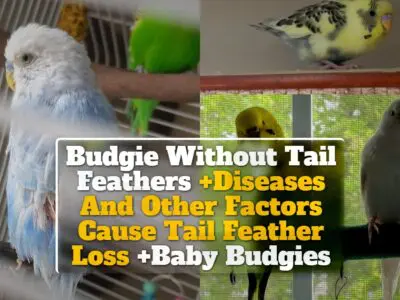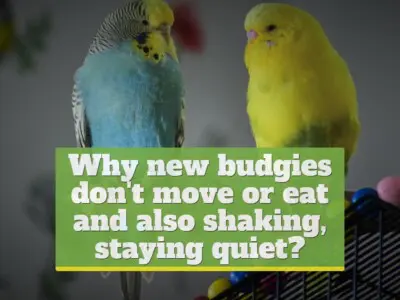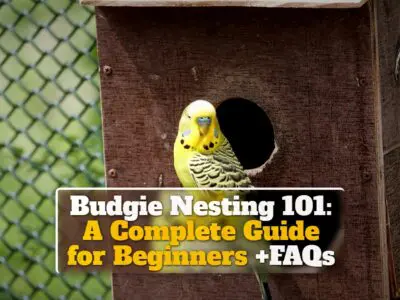Budgies shake their tails side to side, or “wag”, as a form of communication and expression.
This behavior can signify various states such as happiness, excitement, stress, or even a health issue.
Observing the context of this behavior helps in understanding its meaning.
As can be seen, budgies make a tail wagging movement under almost all conditions.
In this case, my advice is to check if it is wagging its tail due to any illness, fear, stress or negative condition.
Other causes of tail wagging, other than health, should be considered natural.
Reasons Of Budgie Shaking Its Tail From Side To Side (Tail Wagging)
Budgies are unique creatures, their behaviors are a complex tapestry woven from strands of communication, social interaction, environmental influences, and even health status.
One of the most engaging displays you might observe is the budgie shaking its tail from side to side, often referred to as tail wagging.
But what does this mean? Is it a cause for concern or merely a charming quirk? Let’s explore the reasons behind this intriguing behavior.
Communication And Contentment
Communication and contentment are two of the most prominent reasons why budgies wag their tails.
Budgies have a complex social structure, and their body language plays an integral part in their daily interactions.
Tail wagging is an essential part of this body language, used to communicate a variety of messages, primarily reflecting a state of contentment and satisfaction with their environment.
Expressing Happiness And Contentment
Budgies can be quite expressive, and one way they convey their happiness and contentment is by wagging their tails.
If your budgie is happily perched in its favorite spot or has just enjoyed a delicious meal, it may express its satisfaction by shaking its tail.
This behavior is essentially the budgie equivalent of a contented sigh or a satisfied smile.
Signaling Comfort And Ease
Another reason why budgies wag their tails is to signal comfort and ease.
Much like a cat purring when it’s comfortable, a budgie may wag its tail to convey a sense of relaxation and peace.
If your budgie is lounging around and shaking its tail from side to side, it’s most likely feeling pretty good about its current situation.
Indicating Excitement Or Anticipation
Sometimes, tail wagging in budgies can denote excitement or anticipation.
Did you just bring out their favorite toy or treat? Your budgie’s wagging tail could be an expression of joy and eagerness.
It’s their own little way of jumping up and down with excitement!
Demonstrating Curiosity And Interest
Budgies are inquisitive creatures, and their tail wagging can also be an indicator of their curiosity and interest.
If they are exploring a new toy, an unfamiliar part of their cage, or even observing a new person, budgies may wag their tails as a part of their exploratory behavior.
Courtship And Mating Behavior
In the natural world, tail wagging often plays a crucial role in courtship and mating behaviors, and budgies are no exception.
The male budgie’s charming tail-wagging displays are especially intriguing.
Part Of Male Courtship Display
Male budgies are known to engage in delightful displays of courtship behavior to woo their female counterparts.
As part of this display, they often wag their tails, showing off their vibrant tail feathers.
It’s a sort of dance move, intended to impress and attract the attention of the female.
Accompanied By Singing, Head Bobbing, And Wing Fluttering
The tail wagging in budgies is often accompanied by other behaviors such as singing, head bobbing, and wing fluttering.
The combination of these actions is like a serenade for the female, enhancing the courtship display’s overall impact.
If you notice your male budgie shaking its tail while also bobbing its head and singing, you’re witnessing a special courtship performance!
Bonding And Pair Formation
As part of their bonding and pair formation process, budgies often wag their tails.
This behavior can signal their interest in the other budgie and their willingness to form a bond.
It’s as if they’re saying, “I like you, and I want to spend more time with you.”
Show Off (Flaunt)
Tail wagging can be a way for budgies to show off or flaunt themselves.
Whether it’s demonstrating their health, energy, or just their colorful tail feathers, the tail wagging can serve as a form of peacock-like display.
This behavior is most commonly seen in males but can be observed in females as well.
Bonding And Affection
In the social world of budgies, bonding and affection are fundamental.
These birds build strong relationships with their fellow budgies and human caretakers.
The act of tail wagging can often be associated with these bonds and the affection that budgies hold for their companions.
Sign Of Affection Towards Humans Or Other Budgies
When a budgie wags its tail in your presence, it may well be a sign of affection.
Budgies have been known to wag their tails at their human caregivers or other budgies they are particularly fond of.
It’s their way of saying, “I enjoy your company” or “I’m glad you’re here.” So, if you’re on the receiving end of a tail wag, feel honored – your budgie is expressing its love!
Expressing Trust And Comfort In Relationships
Budgies also wag their tails as a way of expressing trust and comfort in their relationships.
In the same way that a dog might wag its tail when it sees its favorite human, a budgie might wag its tail to show that it feels safe and secure around a particular person or fellow budgie.
This is an important sign of a strong bond, indicating that your budgie trusts you and feels comfortable in your company.
Playfulness And Happiness
Budgies are naturally lively, energetic creatures.
Their playful spirit is often reflected in their behavior, with tail wagging being a sign of their joy and playfulness.
Indicating Joy And Playfulness
When your budgie is in a playful mood, you might notice it wagging its tail.
This behavior often signifies a burst of joy and playfulness.
It’s as if the budgie is so filled with happiness that it just can’t help but shake its tail.
So, if you see your budgie wagging its tail while hopping around its cage, it’s likely having a great time!
Observed During Playful Activities And Exploration
Budgie tail wagging can be observed during playful activities and exploration.
For instance, if they are swinging on a toy, climbing their cage, or investigating a new object, they might wag their tails in sheer delight.
It’s an expression of their curiosity and love for exploring their surroundings.
Mimicking Behavior
Budgies are known for their remarkable ability to mimic sounds and behaviors.
This talent extends to tail wagging, which can sometimes be a budgie’s attempt to replicate the actions of their human caretakers or fellow birds.
Imitating Behavior Of Humans Or Other Birds
A budgie may wag its tail to imitate the behavior of humans or other birds.
Just as they can learn to mimic words and sounds, they can also mimic physical movements, such as tail wagging.
If they see another bird or a human making a similar motion, they might imitate it, adding another layer of complexity to the reasons why budgies wag their tails.
Stress Or Fear
Not all tail wagging in budgies is a sign of happiness or playfulness.
Sometimes, it can be a response to stress or fear.
Response To Stress Or Fear
In some cases, a budgie might wag its tail as a response to stress or fear.
When they feel threatened or scared, they might wag their tails as part of their defensive response.
It’s important to look for other signs of stress or fear, such as aggressive behavior, hiding, or changes in their normal activities, to understand if this is the cause.
Defensive Or Fearful Behavior
Tail wagging can also be a sign of defensive or fearful behavior.
This can occur if a budgie feels threatened or scared, such as when a new bird is introduced into their environment or during loud noises.
In such cases, tail wagging can be their way of saying, “Stay away, I’m scared!”
Health Issues
While tail wagging is often a normal part of budgie behavior, it can sometimes indicate health issues.
Tail Wagging As A Symptom Of Health Problems
Persistent or unusual tail wagging might be a symptom of health problems.
Respiratory issues, for instance, can cause budgies to wag their tails as they struggle to breathe.
If the tail wagging is accompanied by other symptoms, like loss of appetite or changes in droppings, it might be a sign of illness.
Consultation With A Veterinarian If Persistent Or Accompanied By Other Abnormal Behaviors
If your budgie’s tail wagging is persistent or accompanied by other abnormal behaviors, it’s crucial to consult with a veterinarian.
They can perform a full health check and diagnose any underlying health issues that may be causing the behavior.
Fixing Feathers
Tail wagging is also a part of budgies’ grooming routines.
They wag their tails as a means of fixing their feathers.
Part Of Regular Preening Behavior
Budgies might wag their tails as a part of regular preening behavior.
Preening is the process by which birds clean and align their feathers.
During this process, budgies might wag their tails to shake off loose feathers or debris.
Adjusting And Realigning Tail Feathers
Tail wagging can help budgies in adjusting and realigning their tail feathers.
They might wag their tails to settle their feathers back into place after preening, flying, or moving around.
Removing Dust, Dirt, Or Debris
Lastly, tail wagging can assist budgies in removing dust, dirt, or debris from their feathers.
By wagging their tails, they can shake off any unwanted particles, keeping their feathers clean and smooth.
This is an essential part of their hygiene routine.
Pre-Flight
Tail wagging can also be a part of a budgie’s pre-flight behavior.
This preparatory action ensures they’re in the best shape to take to the skies.
Tail Wagging As Part Of Preparatory Behavior Before Flight
Before they take off, budgies may engage in a series of tail wags as a form of preparatory behavior.
This helps them ensure their feathers are aligned correctly and that they’re ready for flight.
Stretching And Flexing Muscles In Preparation For Takeoff
In addition, budgies use tail wagging to stretch and flex their muscles before takeoff.
This action helps limber up their bodies, preparing them for the physical exertion of flying.
Displaying Readiness And Excitement For Flying
Tail wagging can also be a way for budgies to show their readiness and excitement for flying.
This visual cue can communicate their eagerness and anticipation to other budgies in the vicinity.
Defecation
It may come as a surprise, but tail wagging in budgies is sometimes associated with defecation.
It’s a simple physiological response that helps facilitate the process.
📺 Budgies Wagging Tails Videos
FAQs
In this section, we will answer some of the most commonly asked questions about budgie tail wagging behavior.
Is Tail Wagging A Normal Behavior In Budgies?
Yes, tail wagging is a normal behavior in budgies.
It can signify a range of emotions and states, from happiness and excitement to stress or fear.
However, if the tail wagging is excessive or accompanied by other signs of illness, it’s recommended to consult with a veterinarian.
Should I Try To Prevent Tail Shaking In My Budgie?
Generally, there is no need to prevent tail shaking in your budgie unless it’s indicative of stress, fear, or illness.
Tail wagging is a natural part of their behavior and communication.
What Should I Do If My Budgie Starts Wagging Its Tail Excessively?
If your budgie starts wagging its tail excessively, the first step is to observe for other signs of stress or illness.
If any other abnormal behavior is noticed, it’s crucial to consult a veterinarian promptly.
How Can I More Easily Understand Why Budgies Are Wagging Their Tails Side To Side?
Understanding why budgies wag their tails involves observing their overall behavior, environment, and physical condition.
By taking into account all these factors, you can get a better understanding of what your budgie’s tail wagging might be communicating.
Furthermore, understanding budgie behavior in general, including vocalizations and other physical cues, can also provide more context.
How Does Tail Wagging in Budgies Differ From That in Other Bird Species?
Budgie tail wagging, while similar to other bird species, also has unique characteristics.
While many birds wag their tails as a sign of agitation or to shoo away parasites, budgies often use tail wagging to communicate various emotional states and conditions.
The specifics can vary depending on the individual budgie’s personality, health, and environment.
Does Tail Wagging Mean My Budgie Is Stressed?
Yes, sometimes tail wagging can be a sign that your budgie is experiencing stress.
However, it’s important to look at the context and other behaviors.
If your budgie is also exhibiting signs such as ruffled feathers, decreased appetite, or changes in vocalization, this could indicate stress.
Consult with a veterinarian if you are concerned.
Can Budgie Tail Wagging Indicate Illness?
Yes, tail wagging in budgies can sometimes be a symptom of underlying health problems.
If the behavior is persistent, accompanied by other abnormal behaviors or physical symptoms (like changes in droppings, eating habits or breathing difficulty), it is advisable to consult with a veterinarian.
Is Tail Wagging Common in Young Budgies?
Yes, tail wagging is a behavior that can be observed in budgies of all ages, including young ones.
Young budgies often exhibit this behavior during playful activities and exploration, as well as in response to new experiences or environments.
However, excessive tail wagging might indicate stress or health issues.
How Can I Differentiate Between Normal and Excessive Tail Wagging?
Normal tail wagging is usually brief and occurs in response to specific situations like excitement, playfulness, or communication.
Excessive tail wagging might be continuous or recurrent without a clear cause, and could be accompanied by other abnormal behaviors or symptoms.
If in doubt, it’s best to consult a veterinarian.


